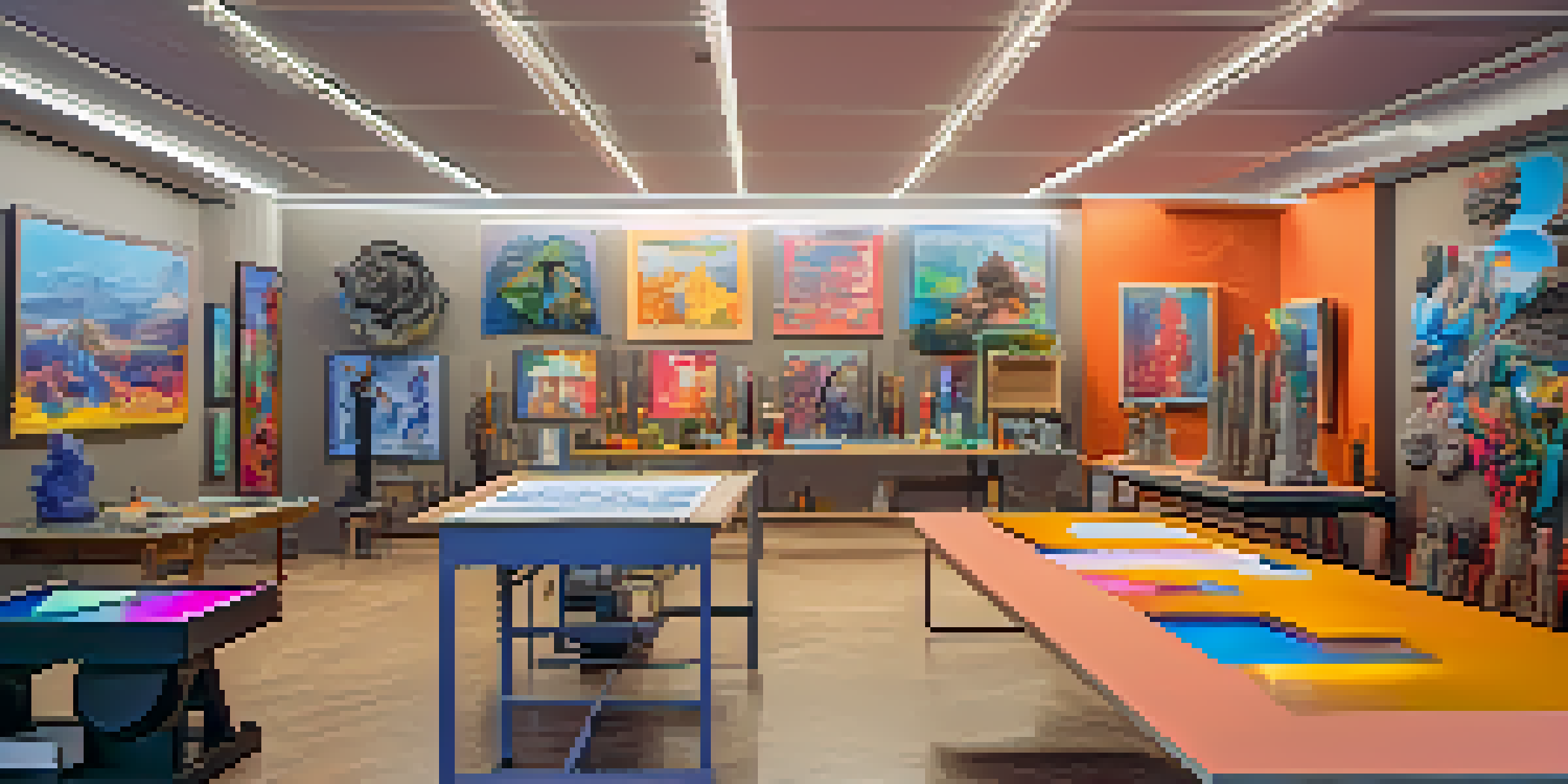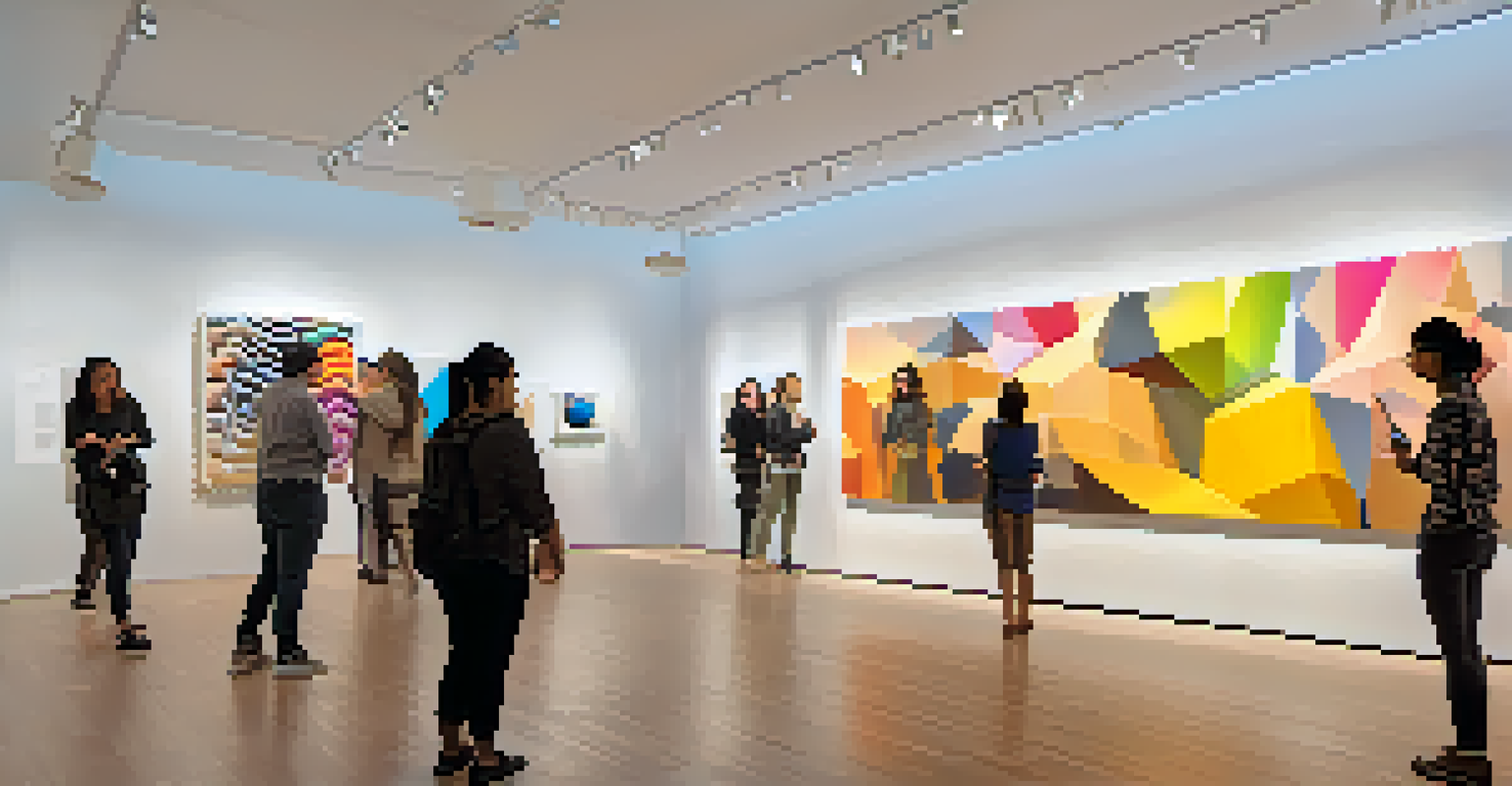3D Printing: A New Dimension in the Art of Painting

Understanding 3D Printing in the Art Scene
3D printing, often referred to as additive manufacturing, is a process where materials are layered to create three-dimensional objects. In the art scene, this technology has opened up a whole new realm of possibilities for artists, allowing them to bring their imaginative visions to life. It's not just about creating sculptures; artists can now explore painting in dynamic and innovative ways that were previously unimaginable.
The artist is a maker of myths, and the myth is the vehicle through which the artist communicates with the viewer.
Imagine a painter who can design their own canvases in unique shapes and sizes or even create textured surfaces that change the way paint applies. This fusion of technology and creativity allows for experimentation that challenges traditional painting methods. With 3D printing, artists can push boundaries, merging the physical and digital worlds in a way that enhances their artistic expression.
As we delve deeper into the intersection of 3D printing and painting, we see the potential for artists to create pieces that are not only visually stunning but also interactive. This new dimension invites audiences to engage with art in a more tactile and immersive manner, reshaping our understanding of what art can be.
The Process: How 3D Printing Works in Art
At its core, 3D printing involves creating a digital model of the desired artwork, which is then sliced into layers for the printer to replicate. Artists can use various materials, from plastic to resin, to create their pieces, allowing for a variety of finishes and textures. Once the model is ready, the printer deposits material layer by layer, gradually building the artwork until it is complete.

One fascinating aspect of this process is the ability to customize designs digitally before printing. Artists can adjust colors, shapes, and even incorporate mixed media elements directly into their creations. This level of control not only saves time but also enables artists to experiment without the fear of wasting materials, making the creative process more efficient and enjoyable.
3D Printing Transforms Artistic Creation
This technology allows artists to blend physical and digital realms, leading to innovative painting techniques and interactive artworks.
Moreover, the accessibility of 3D printing technology has empowered a multitude of artists, from hobbyists to seasoned professionals, to embrace this innovative medium. With more affordable printers and user-friendly software available, the barrier to entry has significantly lowered, encouraging a diverse range of artistic expressions.
Exploring New Artistic Dimensions with 3D Printing
One of the most exciting aspects of 3D printing in painting is the introduction of new dimensions—literally. Artists can create multi-layered pieces that play with depth and perspective, inviting viewers to experience art in a more engaging way. This shift not only alters the visual impact of a painting but also stimulates the viewer's imagination, encouraging them to explore the piece from different angles.
Technology is best when it brings people together.
Take, for instance, an artist who combines 3D-printed elements with traditional painting methods. By layering printed textures over painted backgrounds, they can achieve a stunning interplay between the tactile and the visual. This unique approach not only makes the artwork more dynamic but also challenges the conventional notion of what a painting should be.
Additionally, the ability to create complex structures that would be nearly impossible to achieve by hand offers artists an unprecedented level of freedom. Whether it's intricate patterns, organic forms, or even kinetic sculptures, 3D printing allows for a vast exploration of artistic possibilities.
Case Studies: Artists Embracing 3D Printing
Several contemporary artists have embraced 3D printing as a medium to enhance their work. For example, artist Joshua Harker is known for his intricate 3D-printed sculptures that challenge the boundaries between art and technology. His creations often feature delicate, lace-like patterns that would be challenging to produce using traditional methods.
Similarly, artist Anouk Wipprecht combines fashion and technology by creating 3D-printed garments that also serve as interactive pieces of art. Her work demonstrates how 3D printing can transcend traditional artistic boundaries, blending multiple disciplines to create something wholly unique.
Artists Embrace New Dimensions
3D printing enables artists to create multi-layered pieces that enhance depth and viewer engagement, challenging traditional art forms.
These artists not only showcase the versatility of 3D printing but also inspire others to explore this innovative medium. By sharing their processes and results, they encourage a community of artists to experiment and push their creative limits.
Challenges and Considerations in 3D Art Printing
While 3D printing opens up exciting new possibilities, it also comes with its own set of challenges. One of the primary concerns is the quality and durability of the printed materials. Not all 3D-printed materials are suitable for long-lasting artworks, and artists must carefully consider their choices to ensure the integrity of their pieces over time.
Moreover, the initial investment in 3D printing technology can be daunting for many artists. High-quality printers and materials can be expensive, and the learning curve associated with the technology may deter some from diving in. However, as the technology evolves and becomes more accessible, these barriers are slowly being reduced.
Finally, the question of originality arises in the realm of 3D printing. With the ability to replicate designs easily, artists must navigate the fine line between inspiration and imitation, ensuring that their work remains authentic and true to their vision.
The Future of Painting with 3D Printing
Looking ahead, the future of painting with 3D printing appears bright and full of potential. As artists continue to explore this technology, we can expect to see even more groundbreaking innovations that redefine artistic practices. The incorporation of augmented reality (AR) and virtual reality (VR) could further enhance the interactive aspects of 3D-printed artworks.
Imagine walking through an art gallery where 3D-printed paintings come to life through AR, allowing viewers to engage with the art in ways previously unheard of. This merging of physical and digital experiences could revolutionize how we perceive and interact with art.
Future Potential of 3D Art
The integration of augmented and virtual reality could revolutionize how audiences interact with 3D-printed artworks, expanding artistic expression.
Ultimately, as 3D printing technology advances, artists will have even more tools at their disposal to express their creativity. This exciting evolution not only enriches the art world but also invites a broader audience to appreciate and participate in the artistic journey.
Conclusion: Embracing the Fusion of Art and Technology
In conclusion, 3D printing is not just a passing trend in the art world; it represents a significant shift in how artists create and share their work. By embracing this technology, artists can expand their creative horizons and engage with audiences in innovative ways. The fusion of art and technology has the power to transform not only individual artistic practices but also the entire landscape of the art world.
As we continue to witness the evolution of 3D printing in art, it's essential for artists, collectors, and audiences alike to remain open-minded and curious. This new dimension in the art of painting invites everyone to explore and appreciate the endless possibilities that arise when creativity meets technology.

So, whether you're an artist looking to experiment or an art lover eager to explore this new frontier, 3D printing offers a fascinating glimpse into the future of artistic expression. The canvas may be changing, but the heart of art remains as vibrant as ever.